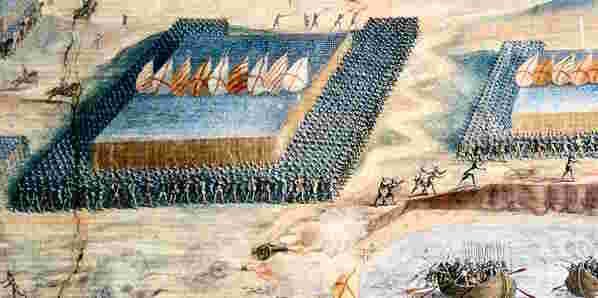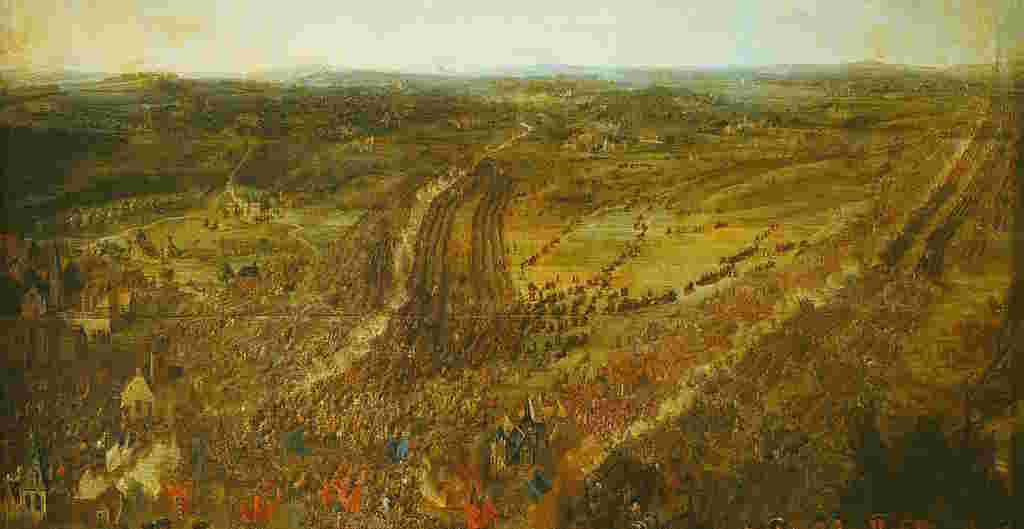17th century armies and Navies
The C17th was a time of upheaval and innovation, and warfare was no exception.
Spain's elite Tercios were the often imitated but never matched standard, whose superiority had been a fact of life for well over a century. They were professional soldiers, not mercenaries or levies, using tightly-disciplined formations of pikemen that almost evoked the phalanxes of Ancient Greek hoplites.
Detail from Desembarco de los tercios
Wiki commons: Monasterio de San Lorenzo de El Escorial, Madrid, Spain
Linear Bataille de Fleuru
Pierre-Denis Martin, Public domain, via Wikimedia Commons

Yet the brutal Thirty Years War was the beginning of the end for the venerable square foot formations. Improvements to musketry and artillery spurred on the adoption of ‘linear' formations as pioneered by the Swedish - the musket-and-bayonet warfare of the gunpowder age was starting to take shape.
The new kid on the block in the mid-C17th, who would capitalise on these developments, challenge the might of the Spanish tercio and provide a model for the armies to come, was the humble but pious volunteer of 17th century armies.
Read more about the military backdrop of English Tangier here.
If the professional Spanish Tercio was the revival of the Greco-Roman idea of a citizen-soldier, the volunteer of 17th century armies was a religiously-motivated crusader.
Dressed in cheaply-dyed red coats and marching into battle with a pamphlet Bible in their pockets, the New Model Army soldiers proved their mettle against Royalist forces during the Civil War and would go on to make their mark on the continent for their ferocity. Their regiments were mostly composed of musketeers over pikemen at a ratio of around 3 to 1, filling the battlefield with gunpowder smoke.
Their supremacy over the supposedly-invincible tercio was shown at the Battle of the Dunes in 1658, when they charged up a 46-metre hill to assault and rout a Spanish position. This moment marked a turning point in European armies, laying the groundwork for a military tradition stretching all the way to the Napoleonic Wars.
England's New Model Army would persist through the Interregnum and into the Restoration. But would their fervour be enough to take over and hold English Tangier?
Read more about the armies and major battles of the time here.
The United Provinces of the Netherlands were one of the mercantile superpowers of Europe, and were intent on keeping things that way.
The Dutch colonial empire was built on the back of Portuguese and Spanish trading routes, and already by the mid-C17th stretched from Taiwan to the Caribbean. Their merchant navy was correspondingly huge and dominated the North Sea, much to the chagrin of the English.
In times of war, the Dutch could simply wheel guns onto their numerous light and manoeuvrable merchant vessels. This gave them the ability to surround, isolate and board the enemy.
Action between English and Dutch Ships

But just as the New Model Army countered the tercios, Cromwell's new war fleet was determined to counter the Dutch. Ships were designed with firepower in mind, standing off against enemy vessels while bombarding them from range instead of getting close and boarding.
The efficiency of the new English navy was proven over the Anglo-Dutch War – but by the time of Charles II's ascent times had changed. England was now potentially facing down the Spanish, Portuguese, Barbary Corsairs and even the French at sea, not just the Dutch.
Could England's ponderously heavy navy protect the supply lines between London and English Tangier?
Find out more about the navies and naval battles of the time here.
In the interest of historical accuracy and scholarly integrity, this site will be updated constantly as more information becomes available or is pointed out to me.
If you notice anything that you think is incorrect, please contact me at john@englishtangier.co.uk and quote the correct source.
If you have any further questions, please e-mail me via my contact form and I will do my best to assist.
Index
Blogs & Resources